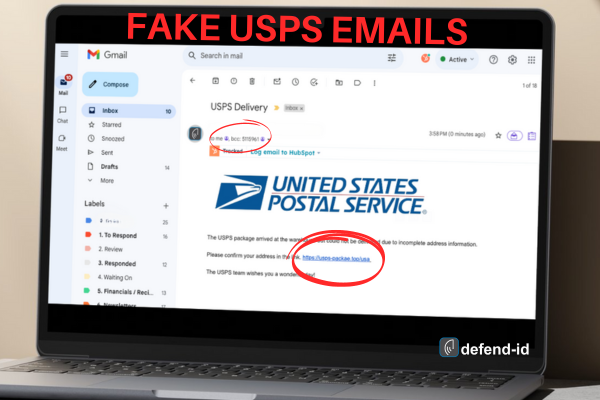
by Brian Thompson | May 29, 2024 | Identity Theft
Beware of Fake USPS Emails: Protect Your Personal Information
Understanding the Scam
Scammers are constantly evolving their tactics to deceive unsuspecting individuals, and one of the prevalent scams involves fake USPS emails. These emails often contain fraudulent information about an attempted or intercepted package delivery and prompt the recipient to click on a link to find out more about the delivery status. Unfortunately, clicking on this link can activate malware designed to steal personal information. Information such as usernames, passwords, and financial account numbers stored on your computer or mobile device.
How the Fake USPS Emails Scam Works
Scammers send emails that look convincingly like they are from USPS, using official logos and language to trick recipients. These fake USPS emails typically include:
- A Subject Line Indicating Delivery Issues: Subjects may read “USPS Delivery Failure Notification” or similar, indicating that there was an issue delivering a package.
- Fraudulent Delivery Information: The body of the email often states that a package was attempted to be delivered on a specific date, but for some reason, it could not be completed.
- A Malicious Link: Recipients are instructed to click on a link to print a delivery label or to find out more about the delivery status. Clicking this link can install malware on your device.
Once the malware is installed, it can log your keystrokes, steal your personal information, and gain access to your financial accounts.
Identifying Fake USPS Emails
To protect yourself from these scams, it’s crucial to recognize the tell-tale signs of fake USPS emails:
- Poor Grammar and Spelling Errors: Legitimate organizations typically do not send out emails with grammatical errors or spelling mistakes. Scammers often make these errors, so it’s a red flag if you notice them.
- Sense of Urgency: Scammers often create a sense of urgency, stating that immediate action is required, or there will be dire consequences. This tactic is meant to pressure you into acting quickly without thinking.
- Requests for Personal Information: USPS will never ask for personal information via email. If an email requests personal information under the guise of reconfirming details, it is likely a scam.
- Unusual Sender Email Address: Check the sender’s email address. Scammers often use addresses that look similar to official ones but may have slight variations or unusual domains.
- Unexpected Package Notifications: The USPS does not notify customers about package delivery attempts by email. If you receive such a message, it is best to assume it is fraudulent.
Real-life Examples of Fake USPS Emails
Customers being targeted will receive an email with a subject line like “USPS Delivery Failure Notification.” The email states that a package was attempted to be delivered on a certain date but could not be completed. It then instructs the recipient to click on a link to print a delivery label and take it to their local post office to pick up the package. This link, however, installs malicious software on the recipient’s computer, logging keystrokes and potentially obtaining personal identification information and account details.
Protecting Yourself from Fake USPS Emails and Email Scams
Here are some practical steps you can take to protect yourself from falling victim to fake USPS emails and other phishing attacks:
- Be Skeptical of Unsolicited Emails: Always be cautious of unexpected emails, especially those that claim you have a package waiting or need to take immediate action.
- Check the Sender’s Email Address: Look closely at the sender’s email address. Legitimate emails from USPS will come from an official domain, not a random or suspicious-looking address.
- Hover Over Links Without Clicking: Before clicking on any link, hover over it with your mouse to see the URL. If it looks suspicious or unfamiliar, do not click on it.
- Verify Information with USPS Directly: If you are unsure about an email, contact USPS directly using a verified phone number or their official website. Do not use any contact information provided in the suspicious email.
- Forward Suspicious Emails to USPS: If you receive a suspicious email, forward it to SPAM@USPIS.gov. This helps USPS investigate and address the issue.
- Keep Your Computer and Software Updated: Regularly update your operating system, antivirus software, and any other applications to protect against malware and other threats.
What to Do if You Clicked on a Link in Fake USPS Emails
If you have clicked on a link in fake USPS emails, take the following steps immediately:
- Disconnect from the Internet: Temporarily disconnect your computer from the internet to prevent further data transmission.
- Run a Full Virus Scan: Use your antivirus software to run a full system scan. Remove any detected threats.
- Change Your Passwords: Change the passwords for your email, financial accounts, and any other accounts that may have been compromised. Use strong, unique passwords for each account.
- Monitor Your Accounts: Keep a close eye on your financial accounts and credit reports for any unusual activity. Report any suspicious transactions to your bank or credit card company.
Conclusion
Scams are a growing threat, but with the right knowledge and precautions, you can safeguard your personal information. Always be wary of emails that seem suspicious, and remember that the USPS will never notify you about package deliveries via email. If in doubt, contact the USPS directly to verify the authenticity of any communication. Stay safe and protect yourself from fake USPS emails and other scams by following these simple guidelines.
By staying vigilant and recognizing the signs of a scam email, you can protect your personal information from falling into the hands of cybercriminals. Always be cautious when receiving unsolicited emails, especially those that request personal information or prompt you to click on links. Remember, it is better to be safe and verify the legitimacy of an email than to risk compromising your personal information.
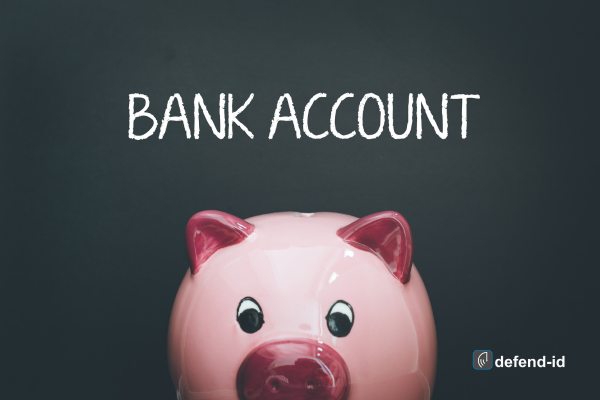
by Brian Thompson | May 8, 2024 | Identity Theft
Identity theft is a bit scary—Compromised Bank Account Identity Theft is really disturbing. Think of how violating that crime is when it comes to invading your bank account. Time is of the essence to secure your money and, of course, any further risk to your identity. This guide is going to walk you through everything you need to know to do so.
Ways to Recognize If a Thief Has Your Bank Account Account:
Signs of your bank account being hacked, you can easily detect. Quickly act on what you detect, the earlier the better.
- Unexplained Transactions: Always review your bank statement for any transaction not made by you. That’s a clear indication of possible unauthorized access.
- Changes in Account Information: Any changes that are made to your personal information on the bank’s records not made by you should raise concern.
- Locked Out of Account: If you are suddenly locked out of your online banking account, it might be because someone else has gained access.
- Unfamiliar Charges on Credit Reports: Regularly review your credit reports for unfamiliar inquiries or accounts.
- Missing Mail: Missing bank statements could suggest that an identity thief has changed your address.
- Alerts from Your Bank: Pay attention to any alerts from your bank regarding suspicious activities.
- Declined Transactions: If your card is unexpectedly declined, it could be an indicator of fraudulent activity or that the bank has locked your account.
Immediate Steps to Take After Discovering Fraud
Contact your bank
- Contact Your Bank Immediately: As soon as you notice any suspicious activity, contact your bank’s fraud department. This is critical to prevent further unauthorized transactions.
- Secure Online Accounts: Change the passwords and PINs for all affected accounts, including your online banking access. Choose strong, unique passwords for each account to enhance security.
Engage with Credit Bureaus
- Place Fraud Alerts: Contact one of the three major credit bureaus—Equifax, Experian, or TransUnion to place a fraud alert on your credit reports, making it more difficult for identity thieves to open new accounts in your name.
- Consider a Credit Freeze: A credit freeze prevents new creditors from accessing your credit report, which stops new account openings. Visit AnnualCreditReport.com to learn how to apply for a freeze.
Report the Incident
- Federal Trade Commission (FTC): File a report with the FTC at IdentityTheft.gov. This site also provides a personalized recovery plan.
- Local Law Enforcement: Report to local police if significant financial loss is involved or if you possess information about the identity thief.
Prevention: Safeguarding Your Information
- Educate Yourself and Family: Stay informed about common tactics employed by identity thieves and educate your family on protecting personal information. Navigating the Digital Labyrinth: Safeguarding Your Identity in a Technology-Driven World
- Secure Personal Documents: Keep sensitive documents in a secure location and dispose of them properly when no longer needed.
While the immediate aftermath of discovering your bank account has been compromised is stressful, taking structured, informed steps can greatly mitigate the damage. By following the outlined procedures, you can not only address the current fraud but also enhance your defenses against future threats. For more detailed steps and assistance, visiting websites such as the FTC’s IdentityTheft.gov can provide tailored recovery plans based on your specific situation.
Articles related to Compromised Bank Account Identity Theft:
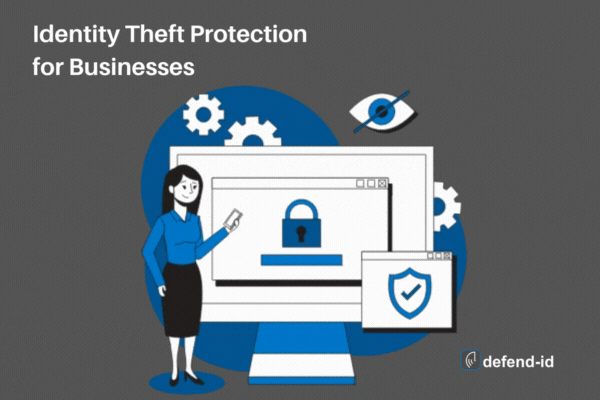
by Brian Thompson | Apr 24, 2024 | Breach, Employee Benefits, Identity Theft
The need for robust identity theft protection is critical as businesses face growing cyber threats.. Annually, millions are affected by identity fraud, with businesses bearing a substantial brunt—both in terms of compromised employee data and overall organizational integrity. Beyond a mere perk, identity theft protection is essential for maintaining productivity, safeguarding sensitive information, and attracting and retaining top talent.
Benefits of Identity Theft Protection for Businesses:
- Reduced Employee Disengagement: Studies show resolving identity theft issues can take 100-200 hours, leading to decreased focus and productivity. Identity theft protection services help mitigate these disruptions, allowing employees to concentrate on their work without the added stress of personal security breaches.
- Enhanced Corporate Security: Employee identity theft can lead to broader data breaches affecting company data and client trust. Offering identity theft protection helps reduce the risk of such breaches, strengthening your cybersecurity posture and shielding both employee and corporate data from cyber threats.
- Ongoing Security Education: Identity theft protection programs include education on the latest security practices and vulnerabilities. This proactive approach empowers employees to safeguard their personal and professional data, contributing to overall corporate security.
- Safeguarding Corporate Information: Identity theft protection services monitor and alert employees about suspicious activities linked to corporate assets like credit cards and login credentials. This monitoring helps prevent unauthorized access, protecting sensitive data from cybercriminals.
- Attracting and Retaining Top Talent: Offering identity theft protection as a benefit can significantly enhance your company’s appeal to prospective employees, particularly millennials, who are projected to make up 75% of the workforce by 2025. Modern benefits like these demonstrate a company’s commitment to employee well-being, making them attractive places to work.
Building Trust and Loyalty:
A company’s reputation is bolstered by offering identity theft protection. This benefit showcases that a company cares about its employees’ safety and personal data, which can improve trust and loyalty among current employees and attract new ones.
Beyond Individual Protection:
Identity theft protection services go beyond individual protection, enhancing overall corporate security. They provide tools that monitor and report potential security breaches, not just internally but also on external platforms like social media and the dark web, where stolen data can be found.
Early Detection and Fast Resolution:
Identity theft protection services specialize in the early detection of identity threats, critical for minimizing damage. They monitor various channels to quickly identify and address potential threats before they escalate into serious issues.
Comprehensive Protection Features:
Many identity theft protection plans offer features beyond basic monitoring, including:
- Credit Lock: to restrict access to your credit report and prevent unauthorized accounts from being opened.
- Social Media Monitoring: to track your social media profiles for suspicious activity.
- Password Management Tools: to securely store and manage strong passwords.
These features provide layered security, helping employees protect their digital footprints from potential cyber threats.
Financial Protection and Support:
Financial recovery from identity theft can be daunting. Most identity theft protection services include insurance to cover financial repercussions like legal fees and lost wages, providing essential support during recovery. They also offer mitigation services like dark web monitoring and many others. The most important factor is their ability to help employees recover when fraud does occur!
Investing in identity theft protection is more than a security measure. It is a strategic business decision that enhances your corporate image, increases data privacy, and ensures a resilient organizational culture.
Ready to fortify your business against identity theft? Download your free Defend-ID Identity Theft Response Plan now and take a pivotal step toward comprehensive business security and employee satisfaction!
Articles related to identity theft protection for businesses:
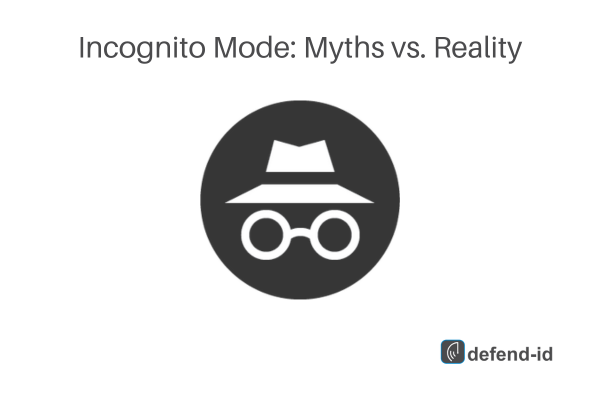
by Brian Thompson | Apr 18, 2024 | Employee Benefits, Identity Theft
Incognito mode, or private browsing, is a feature found in most modern web browsers like Google Chrome, Firefox, and Safari. It promises a level of privacy and secrecy by not saving your browsing history, cookies, site data, or information entered in forms. Understanding the nuances of incognito mode misconceptions is crucial for using this feature effectively.
What Incognito Mode Actually Does
- No Local Trace: When you use incognito mode, your browser does not save your browsing history or cookies after you close the window. This means anyone else using the same device won’t be able to see what you were doing.
- Session Isolation: Each incognito session is isolated from the other. If you sign into a website in incognito mode, your login state won’t carry over to the normal browsing windows. This is particularly useful for accessing multiple accounts simultaneously.
- Some Forms of Shield Against Tracking: While not foolproof, using incognito mode can reduce tracking from some cookies, as they are deleted once you close the window.
Popular Myths vs. Reality
- Myth: Incognito mode makes you invisible online.
Reality: Incognito mode does not hide your IP address or encrypt your traffic. Your internet service provider (ISP), websites you visit, and network administrators can still see your activity.
- Myth: It is a tool for anonymous browsing.
Reality: Incognito mode does not offer anonymity. For true anonymity, one would need tools like VPNs or the Tor browser.
- Myth: You are safe from malware and viruses in incognito mode.
Reality: Incognito mode does not protect you from viruses or malware. It only prevents your browsing history and cookies from being saved.
The Privacy You Get (And Don’t Get) With Incognito Mode
While incognito mode offers a basic level of privacy by not saving your history or cookies, it does not protect you from all types of surveillance. Employers, ISPs, and websites can still track your visits and interactions through various means like your IP address.
Better Alternatives for Serious Online Privacy
For those who are serious about maintaining privacy online, consider the following:
- VPNs (Virtual Private Networks): A VPN encrypts your internet connection and hides your IP address, providing a much higher level of privacy than incognito mode.
- Tor Browser: For maximum anonymity, the Tor browser routes your traffic through multiple nodes, making it extremely difficult to track.
- Secure Browsers: Browsers like Brave are built with privacy in mind, offering various features to block trackers and ads by default.
Conclusion: Is Incognito Mode Enough?
While incognito mode is helpful for keeping your local browsing private, it’s not a one-stop solution for all privacy needs. Knowing its limitations helps set realistic expectations about what privacy you can actually achieve while online.
Remember, no tool is perfect, but understanding the tools you use can make a significant difference in your digital life. So, next time you go incognito, remember that it’s just one piece of the privacy puzzle.
FAQs about Incognito Mode:
- Does incognito mode save any data?
No, it does not save your browsing history, cookies, site data, or information entered in forms on your device after you close the session.
- Can my employer see what I browse in incognito mode if I’m on a company network?
Yes, your employer can still track your browsing activity if you are connected to the company’s network.
- Is incognito mode the same in all browsers?
While the core functionality is the same, some browsers might offer slight variations in how they handle cookies and data during incognito sessions.
If you’re ever in doubt about what incognito mode can do for you, just remember it’s great for keeping things off your local machine but not much else when it comes to the wider web. For anything beyond that, you’ll need to beef up your privacy tools arsenal.
Article related to incognito mode misconceptions:
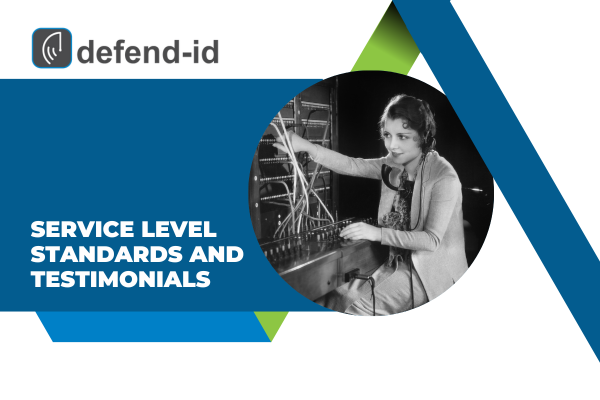
by Brian Thompson | Apr 10, 2024 | Identity Theft
Fully Managed Recovery (FMR), is a service that provides more than just peace of mind; it offers a lifeline in the crazy aftermath of identity theft. FMR is a service that performs all tasks necessary to reclaim your identity, from completing and filing forms to contacting relevant companies, agencies, and financial institutions. It’s a comprehensive approach that leaves no stone unturned in the quest to rectify every fraudulent activity tied to your identity. Service Standards and Client Testimonials are a metric we use to ensure we deliver!
FMR is the foundation of our services and we are grateful to have an amazing team of recovery advocates. The stats and customer testimonials say it all.
2024 Q1
1st QTR : Resource Center Inbound Call Stats (All Queues) All stats are within Goal.
- Abandon Rate: 1.4% (Goal <3%)
- Avg Speed Answer: 0:16 (Goal <:20 seconds)
- % Calls Accepted 83.1% (Goal >80% in 20 seconds)
Fully Managed Recovery Testimonials
- “All my communications were met with very professional interactions.” Frank T. Defend-ID
- “I am very pleased with my interactions and services I received.” Robert S.
- “Excellent representative, very helpful and eager to help.” Marie W.
-
” “I appreciate how quickly I received information to assist in protecting my identity and credit. I have since accessed my credit info through the service provided. I felt I was taken seriously, and your assistance was prompt and useful. Thank you.” Cynthia P.
- “Very thankful for this service. We feel a sense of comfort knowing that this service has been made available to us! Thank you!” Martha H.
- “Your service was very helpful during a very traumatic time. Thank you.” Patricia M.
-
“Such a relief to have my concerns addressed professionally by my personal advocate. Thank you.” Linda B.
- “All I have to say is… Thank you, thank you, thank you! 😊” Terri W.
- “Overall, all my dealings with my recovery advocate were very professional.” Kevin O.
- “My advocate was extremely professional and kind during this difficult time.” Camille C.
- “I appreciate all the time, effort and information given!” Julie H.
- “My Restoration Specialist did a job well done. Many Thanks.” Raymond C.
-
“My Advocate was a pleasure to have as our representative. She clearly understood our concerns and was very patient, taking time to answer every question we had. From our experience, she is a valuable asset to your company.” Lucinda H.
- “My Restoration Specialist gave excellent customer service throughout the original and call back communication. Thank you.” Ward L.
- “I’m truly thankful for the assistance provided and the services received.” Carole S.
-
“I’ve had to use these services a couple times of the last several years and the service I’ve received was fantastic and the recovery advocates did an outstanding job.” Heather B.
- “My Advocate’s help was excellent, and she gave me her direct contact info in case anything else arises.” Jane A.
- “My advocate did an excellent job in explaining services and providing resolutions to my ID theft event.” Todd S.
Fully Managed Recovery service stands out as a place to turn when your world gets turned upside down. It’s not just about the statistics or the breadth of coverage; it’s about the stories of individuals who’ve had their burdens lifted and their identities restored. It’s about knowing that in your moment of need, you have a dedicated advocate ready to fight in your corner.
Articles related to Service Standards and Client Testimonials:
Are you Protecting your employees with Identity Theft Protection? Connect with us: sales@defend-id.com

by Brian Thompson | Apr 3, 2024 | Breach, Identity Theft
Cyber threats are as common as coffee breaks, making the myth that cybersecurity falls solely within the world of IT is a terrible oversight. It’s a wide-reaching challenge touching every role from the ground floor to the executive suite. This article aims to dismantle the outdated view of cybersecurity, highlighting the essential role of identity theft protection and individual responsibility in creating a secure digital environment for businesses. Cybersecurity- More Than Just IT’s Job
Everyone Has a Part to Play
Gone are the days when cybersecurity efforts are the sole responsibility of the IT department. In today’s workplace, a single click on a malicious link by any employee can open the floodgates to cyber threats. It’s a reality that highlights the importance of every team member’s role in cybersecurity.
Employees at all levels frequently handle sensitive data, making identity theft protection an essential element of an organization’s overall cybersecurity strategy. Simple habits, such as regularly updating passwords, recognizing phishing attempts, and securely managing personal and professional information, can significantly reduce the risk of identity theft and data breaches.
Training: First Line of Defense
Knowledge is essential when it comes to protecting against cyber threats. Regular, engaging training sessions can transform cybersecurity from an abstract concept to a fundamental practice embraced by all. These sessions should not only cover the basics of cyber hygiene but also the nuances of identity theft and how individuals can safeguard their digital personas.
An environment where cybersecurity is discussed openly and questions are encouraged can demystify the subject, making it more approachable for everyone. Remember, a well-informed employee is an organization’s first line of defense.
Leadership’s Role
The tone for cybersecurity readiness is set at the top. Leadership’s commitment to cybersecurity is critical. Allocating resources for security initiatives, setting clear policies, and fostering a culture where security is everyone’s business, leaders can elevate cybersecurity from a niche IT concern to a universal priority.
Executives and managers should lead by example, demonstrating good cyber practices and actively participating in training sessions. This not only reinforces the importance of cybersecurity but also signals to every employee that their role in protecting the organization is valued and vital.
Cultivating a Culture of Security
Building a culture that prioritizes cybersecurity requires more than just annual training sessions; it demands a shift in mindset. Recognizing and rewarding employees who adhere to security practices can motivate others to follow suit. Similarly, creating channels for reporting suspicious activities without fear of retribution encourages a proactive stance against cyber threats.
Such a culture not only enhances the organization’s resilience against cyber attacks but also fosters an environment where security becomes second nature and part of the daily activities of every employee.
The Collective Shield
The narrative that cybersecurity is an exclusive domain of the IT department must be left in the past. With cyber threats becoming more sophisticated, the responsibility falls on each of us. Every employee, from new hires to the CEO, must understand cyber risks. Embedding strong identity theft protection is crucial for all.
Emphasizing collective responsibility for cybersecurity fosters an environment where everyone is empowered to contribute to the digital safety of the organization. It transforms cybersecurity from a daunting challenge into a shared mission, reinforcing the idea that, together, we are a formidable shield against cyber threats.
Cybersecurity- More Than Just IT’s Job
Dismantling the myth that cybersecurity is just IT’s job is no small feat, but it’s a necessary step toward building more protected organizations. We must embrace our roles and focus on strong identity theft protection. Fostering a culture of security awareness will safeguard our digital realms.
Get your identity theft response plan here:  https://defend-id.ac-page.com/employee-identity-theft-response-plan?test=true
https://defend-id.ac-page.com/employee-identity-theft-response-plan?test=true
Articles related to “Cybersecurity- More Than Just IT’s Job”






